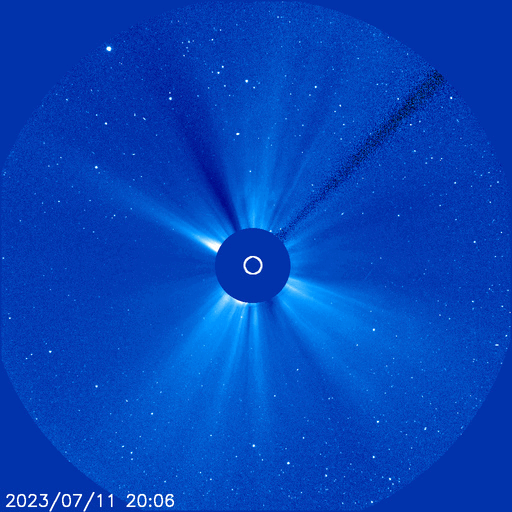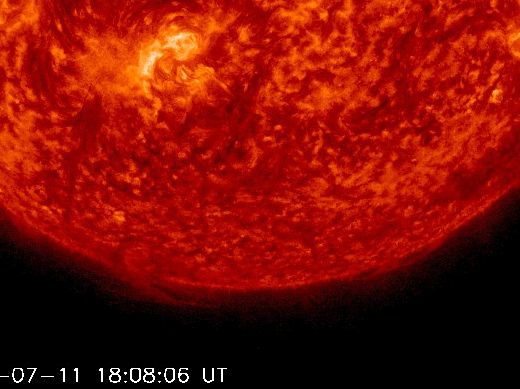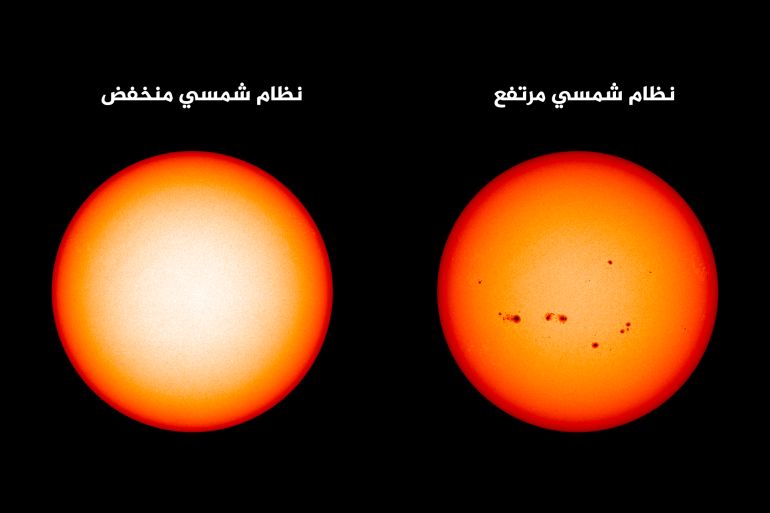The current solar cycle reaches its peak in 2025 and is expected to be one of the strongest solar cycles
Weather of Arabia - Analysts from the US National Weather Service (NOAA) and NASA agreed to predict that the Earth's magnetic field would encounter coronal mass body energy (CME) between July 14 and 15. According to reports by SpaceWeather.com , the collision could lead to G1-class solar storms, with aurorae appearing in high-latitude regions. The particle cloud was launched into space on July 11 by a magnetic filament that exploded in the sun's southern hemisphere.

What is a magnetic thread?
In the context of heliophysics, the term "magnetic filament" or "filament" refers to a long, thin structure made of plasma (ionized gas) that appears as a dark or cool feature against the Sun's hotter background light. The filament is also known as a solar flare when viewed from a different angle. The filament is usually associated with magnetic fields and is usually found at the boundaries of active regions on the Sun's surface. The filaments can stretch thousands of kilometers and are held in place by magnetic forces within the sun's atmosphere. Sometimes, these filaments can become unstable and explode, releasing energy and particles into space. This is known as a magnetic filament implosion.
What is coronal mass ejection (CME)?
A coronal mass ejection (CME) is a phenomenon in the sun that is the release of a large amount of charged matter into space from the solar corona. This matter mainly consists of plasma made up of electrons and protons. Coronal mass eruptions occur when these massive magnetic masses are suddenly released and accelerated from the surface of the Sun as a result of changes in the solar magnetic fields. When this charged mass reaches Earth, the Earth's magnetic field interacts with it, causing disturbances in the near-Earth space environment. This can cause phenomena such as solar storms and the appearance of the aurora borealis over geographically wide areas.

What is a "solar storm"?
A perturbation of the Earth's magnetic field caused by solar activity, particularly intense solar flares or coronae mass eruptions (CMEs). When the corona mass eruption or the fast solar wind current reaches Earth, they interact with the Earth's magnetic field that surrounds the planet. This interaction can cause fluctuations and disturbances in the Earth's magnetic field, resulting in a geomagnetic storm.
During this storm, Earth's magnetic field lines can deform dramatically, and energetic particles from the solar event can penetrate the magnetic field and reach the upper atmosphere. This can result in various effects, such as the appearance of the aurora borealis at lower latitudes than normal, fluctuations in power grids, disruptions to satellite communications and navigation systems, and in rare cases, damage to sensitive electronic equipment.
Typically, solar storms are classified on different levels or scales based on their intensity, with the most severe storms classified as G5. The effects of the storm can vary according to factors such as the strength and direction of incoming solar activity and the state of the earth's magnetic field in general.

The peak of the current solar cycle will be in 2025
The solar cycle is characterized by a series of changes in solar activity over a period of about 11 years. These cycles are monitored by tracking the number of sunspots, their activity, and associated magnetic phenomena.
"Solar Cycle 25" began in 2019 and is expected to continue until 2030. According to current forecasts, the current solar cycle is expected to reach its peak in July 2025. High solar activity during this cycle indicates the possibility of an increase in the number of sunspots and the occurrence of sun flashes and coronal mass ejections.
Solar storms are electromagnetic pulses, and they can cause devastating effects on Earth if they are strong enough.
According to a spokesman for the National Oceanic and Atmospheric Administration, he confirms that following the sun's cycles and forecasts gives a rough idea of the frequency of space storms of all forms, from radio signal outages to geomagnetic storms and solar radiation storms.
Some network systems may experience a breakdown or power outages, and fears about an internet apocalypse arise due to expert Sanjith Adeo Jyothi's comments in 2021 in a research paper dealing with the issue.
A solar flash cuts off radio communications in western America
A huge solar flash occurred on July 2nd, and caused a temporary broadcast outage in the western United States and the Pacific Ocean. The flash from an active region on the Sun's surface known as AR 3354 has been described as being of type X1.0 . This flash is considered one of the strongest flashes that have been observed coming from the sun.
According to the press release issued by NASA on July 3, 2023, the Earth's upper atmosphere was affected by a solar flare. As a result, high-frequency radio signals interfered in the area exposed to the sun at that time.
The flash did not have a serious effect on the ground as expected, as it faded without any further incident.
In addition, no coronal mass ejections have been detected by astronomers, and they are considered to be a massive outburst of solar wind that releases a large amount of charged and magnetic matter from the sun's outer layer. This type of event is usually associated with the release of streams of plasma into space.

Solar cycle 25
This solar flash coincides with the current solar cycle known as "Solar Cycle 25" . This indicates expectations of an increase in the strength of solar activity during the coming months and years when we approach the peak of the 11-year solar cycle.
The Royal Observatory in Belgium reported that the number of sunspots has reached the highest level in the past 21 years, with an average of 163 sunspots per day during the month of June. Thus, the data indicates that the current solar cycle has shown more activity than predicted by NASA, with the official forecast being around 115 sunspots at the peak.
Scientists are still not sure why the solar activity is higher than expected. Therefore, further study of these events is necessary to understand the internal processes of the sun.

Previous effects of solar flashes on Earth's population
In 1859, the Earth witnessed a rare and famous astronomical event known as the "Carrington Event"; As a strong solar storm caused widespread repercussions on terrestrial communications, with severe damage recorded. And its impact was not limited to that, as the impact of the storm was also evident in the appearance of radiant and amazing auroras around the world. This event occurred just before the expected peak of the then tenth solar cycle. And it had a significant impact on the telegraphic communication system in some areas.
Although solar cycle No. 25 is not the strongest in history, scientists expect it to become one of the most powerful solar cycles.
Arabia Weather App
Download the app to receive weather notifications and more..



